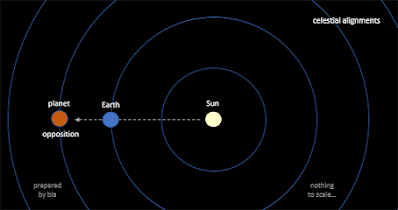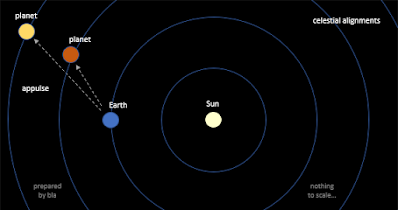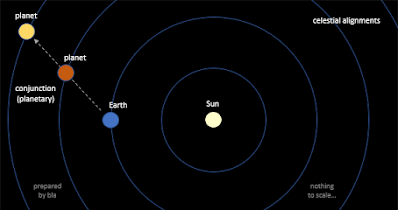opposition
A planetary opposition occurs when an "outer" planet is opposite the Earth from the Sun. A line could be drawn from the Sun, through the Earth, and onward to the planet in question. An Earth sandwich.Outer planets refer to Mars, Jupiter, and beyond, of course. All this can apply to minor planets, dwarf planets, asteroids, comets, etc.
Oppositions are significant because the Earth is as close as it can get to the outer planet, at least in terms of celestial alignment. A notable special case is Mars where it follows a highly elliptical orbit making some oppositions much better than others.
In general, an opposition with a distant outer planet, Jupiter and beyond, happens about every year. That's because our planet zips around the Sun faster. The outer planets moving slower you can think of as being in nearly the same position one year later. For Jupiter, it's actually close to 400 days. Mars? 780 days! Mars is movin' fast and it takes a while to catch up! Beep beep.
If you substitute the Moon for the red planet position above and the alignments are perfect in three dimensions, the Earth will block some of the sunlight reaching the Moon. This we refer to as a lunar eclipse. Curiously, no one refers to the circumstance as "the Moon is at opposition."
solar conjunction
When a planet is on the opposite side of the Sun from the Earth, with the Sun in the middle, we call this a conjunction. Specifically, a solar conjunction.
Personally, I don't get excited about these events. I don't add the particulars to my astronomy planning calendar. Partly because there is nothing to see.
Given the small planet could be behind the large Sun, the Sun would literally block the view from Earth. But the more immediate consideration is that the planet, even when not perfectly aligned with the Sun, is extremely close to the Sun. When the Sun up in our daytime sky, there's no way to see the planet given the bright blue sky and the intense glare of our star.
In fact, there's a danger element here. Do not attempt to view planets near to the Sun, before, during, or after conjunction. Certainly do not use magnification, i.e. binoculars or telescope. The risk of damaging your eyes is too great.
All that said, the "moment" of conjunction with the Sun is significant astronomically even though we cannot directly observe it. It means that the planet which was in the evening sky a short while ago is now transitioning to the morning sky.
Again a solar conjunction is a moment in time and we can take two things away from these events:
- the planet is currently not visible
- it will show up though, soon, in the morning sky...
inferior and superior solar conjunction
The "inner" planets will periodically align with the Sun as viewed from the Earth. Actually, it will happen two times during each inner planet's orbit...
The inner planets refer to Mercury and Venus, both closer to the Sun than the Earth.
The illustration shows the tan planet between the Earth and the Sun. This is referred to as inferior conjunction or inferior solar conjunction.
The beige planet is on the other side of the Sun but still lined up with the Earth. When an inner planet is on the far side of the Sun from the Earth, we call this superior conjunction. [ed: Graphic updated.]
Like in the previous scenario, an inner planet on the far side of the Sun will be invisible due to bright, dangerous glare of the Sun.
If someone says the inner planet is "opposite" the Sun, that choice of wording might be misconstrued as "opposition." That's why I've been trying to avoid the usage.
Now something neat can happen when an inner planet is at inferior conjunction and everything is aligning perfectly: you can get a solar transit.
Transits of Mercury are somewhat common but difficult to observe as Mercury is so small. I observed and imaged the 2016 May 9 event. The last one occurred on 2019 Nov 11. I watched it on the internet. The next is 2049 May 7.
Transits of Venus are rare. The last one was 2012 Jun 5. I was fortunate and viewed and imaged it. A really fun day.
It should go without saying that solar transits are dangerous to observe. You must use proper filters for your eyes, camera lenses, binoculars, and telescope.
One more thought experiment. If you swap the Moon for the tan planet in the diagram above, put the Moon between the Sun and the Earth, and the alignment in 3D space is perfect, you get a solar eclipse.
Then there's the sub-types of solar eclipses: partial, annular, and total. Some argue a total solar eclipse, where the Sun is completely blocked by the Moon, should be called an occultation.
An occultation is was one object blocks the view of another. The most common usage of this is when an asteroid occults a star or the Moon occults another celestial object, say a planet or a double star.
appulse
An appulse describes when two celestial objects are relatively close to one another from our perspective on the Earth.
planetary conjunction
A conjunction of planets may occur when two planets line up well as viewed from the third rock from the Sun.







No comments:
Post a Comment